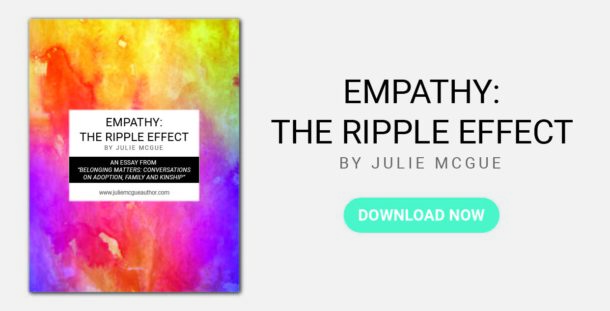What is Positive Adoption Language?

Julie McGue
Author
Recently, I was corrected by a friend of mine who has a son she adopted thirty years ago. I’d referred to my own situation – an adoptee from the closed adoption era – as having been “given up for adoption.” This was a commonly used term from the 1950s, but nomenclature surrounding adoption has changed a lot since then. My friend pointed out that the correct language is “placed for adoption.”
While I didn’t argue with my friend, I don’t agree.
As an adoptee, I consider myself as having been “given up,” because I gave up something when I was adopted. I lost all sense of who I’d been and where I came from before my adoption. Illinois state law blocked my “right to know” until 2011. I was 52 when I learned my personal story – that’s a long time to go without knowing the basic circumstances of one’s existence.
As an adoptive parent, I can see how “placed for adoption” sounds more positive than “given up.” The well-meaning debate with my friend left me wondering if this more modern, positive adoptive language just sanitizes a complex situation. Like any topic, it depends on which side of the controversy you sit.
When did this shift in adoption language occur?
The change in adoption language came as a result of adoption reform in the 1970s. Here’s a bit of helpful history (from Wikipedia):
“The controversy arises over the use of terms which, while designed to be more appealing or less offensive to some persons affected by adoption, may simultaneously cause offense or insult to others. This controversy illustrates the problems in adoption, as well as the fact that coining new words and phrases to describe ancient social practices will not necessarily alter the feelings and experiences of those affected by them. Two of the contrasting sets of terms are commonly referred to as positive adoption language (PAL) (sometimes referred to respectful adoption language (RAL)), and honest adoption language (HAL).
In the 1970s, as adoption search and support organizations developed, there were challenges to the language in common use at the time. The term “natural mother” had been in common use previously. The term “birth mother” was first used in 1956 by Nobel Prize winning author and adoptive mother Pearl S. Buck.
Social workers and other professionals in the field of adoption began changing terms of use to reflect what was being expressed by the parties involved. In 1979, Marietta Spencer wrote “The Terminology of Adoption” for the Child Welfare League of America (CWLA),[3] which was the basis for her later work “Constructive Adoption Terminology”.[4] This influenced Pat Johnston’s “positive adoption language” (PAL) and “respectful adoption language” (RAL).[5] The terms contained in “positive adoption language” include the terms “birth mother” (to replace the terms “natural mother” and “real mother”), “placing” (to replace the term “surrender”).”
This chart highlights the major changes in adoption language:
Terms to Avoid:
- Unwanted Pregnancy
- Real parent/mother/father
- Natural parent/mother/father
- Adoptive parent/mother/father
- Natural child/ own child/ one of my own
- Adopted child (vs. own child)
- Abandoned child, unwanted child
- Illegitimate child
- Give up for adoption, put up for adoption, give away, adopted out, abandoned, surrendered, released, relinquished
- To keep her child
- Is adopted
- Child taken away
- Adoption triangle
Positive Adoption Language:
- Unintended Pregnancy
- Birth parent/mother/father
- Biological parent/mother/father
- Parent, mother, father, mom, dad, etc.
- Birth child/ biological child
- My child/son/daughter, adoptee
- Child placed for adoption
- Born to unmarried parents
- Make an adoption plan, choose adoption, place child for adoption, terminated parental rights
- To parent her child
- Was adopted
- Court termination
- Adoption triad
What is the controversy between adoptive parents and adoptees over Positive Adoption Language?
The reasons for its use: Some terms like birth parents, birth mother, birth father were chosen by those working in adoption reform as terms to replace ‘natural’ and it took nearly a decade before agencies, social workers, courts and laws embraced the change in self-referencing. Some adoptive parents supported this change as they felt using “natural” indicated they were “unnatural”. In some cultures, adoptive families face an anti-adoption bias. This can be evident in English-speaking cultures when there is prominent use of negative or inaccurate language describing adoption. So, to combat it, many adoptive families choose the use of positive adoption language.
The reasons against its use: Some adoptees believe “positive adoption language” creates cognitive dissonance, denies certain realities for the adoptee, & treats the status of being an adopted person as if it is something to be ashamed of by insisting adoption should not be part of their identity. Some birth parents see “positive adoption language” as terminology which glosses over painful facts they face as they go into the indefinite post-adoption period of their lives. They feel PAL has become a way to present adoption in the friendliest light possible, in order to obtain even more infants for adoption; i.e., a sales and marketing tool. Some feel the social work system has negatively compromised the intention of the birth family references and other terms, so that either the initial intent needs to be honored, or the terminology must again change (source: Wikipedia).
In it a nutshell, adoptive parents seek to banish the negative attitudes and connotations inherent in adoption’s definition and history, while adoptees don’t want the negative aspects of their adoption glossed over.
So how do we resolve this?
What’s important is the continued dialogue. It highlights different points of view and it serves to improve communication between all parties. Personally, I would have welcomed improved communication with my adoptive parents about any or all aspects of my adoption: identity, belonging, rejection, loss, and search and reunion. My adoptive parents came from the era of “if we don’t talk about it, it didn’t happen,” but that mindset creates confusion, promotes lack of understanding, and hinders relationship building.
The more we talk about the need for acceptable adoption language, the better we understand our own perspective and the ones held by others.
“What’s important is the continued dialogue.”

Snag my in-depth reference guide to best equip you for the journey ahead.



0 Comments